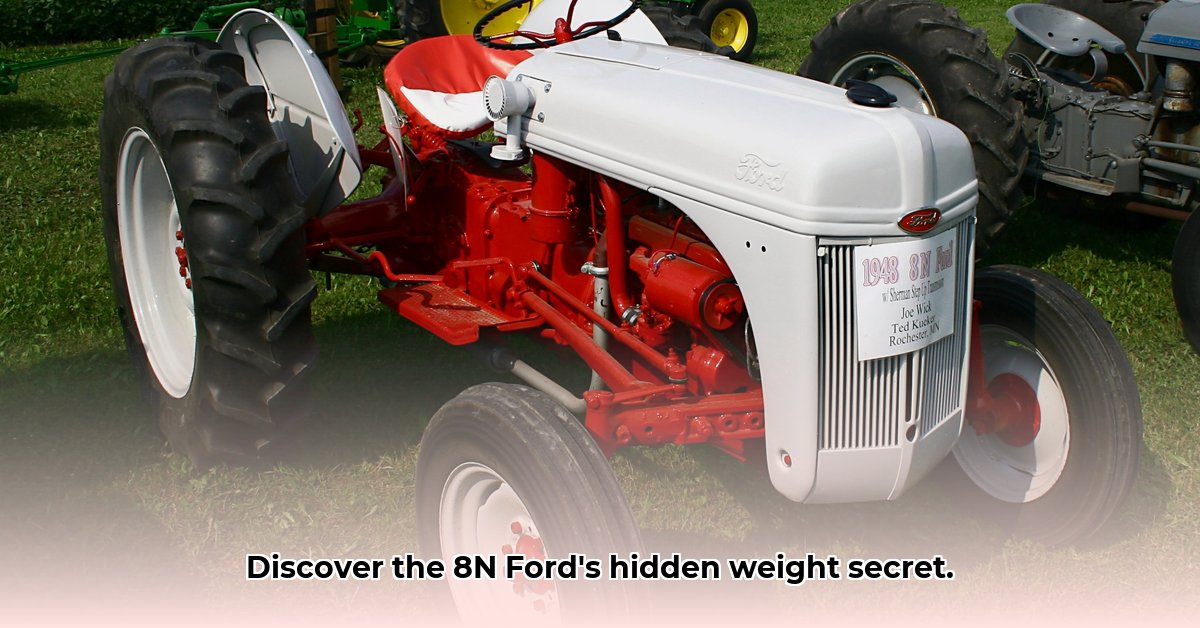
8N Ford Tractor Weight: A Legacy Forged in Steel
The rhythmic chug of a Ford 8N tractor, a sound etched into the memory of generations of farmers, speaks volumes. But beyond the evocative rumble lies a story of innovation, resilience, and a surprising connection to modern sustainable agriculture. This story begins with a seemingly simple detail: the weight of the 8N. While sources vary slightly, placing the weight between 2,200 and 2,400 pounds, this seemingly insignificant figure speaks volumes about its design, its impact, and its enduring legacy. This weight, strategically distributed, wasn't just ballast; it was a key ingredient in the 8N's success. It ensured stability in the field, allowing farmers to tackle even challenging terrain with confidence. The weight, coupled with its power, was a crucial factor in transforming agricultural practices. For more information on specific parts, check out this helpful resource: 8N parts.
More Than Just Metal: The 8N's Specs and Surprises
The 8N, introduced in 1947, boasted a modest yet effective four-cylinder engine, displacing roughly two liters and generating 27 to 30 horsepower at the power take-off (PTO) – a significant power output for its time. This power, combined with its weight, provided remarkable performance. The transmission, however, remains a point of some debate among enthusiasts. While some sources cite a straightforward four-speed gearbox, others suggest a twelve-speed configuration, possibly a Sherman combination. Further research into original documentation is needed to definitively resolve this discrepancy. However, regardless of the specific number of gears, the 8N's weight distribution was a testament to clever engineering, resulting in a surprisingly nimble tractor capable of navigating even the tightest of spaces. Isn't it remarkable how a seemingly small detail like weight can influence a machine's overall functionality?
A Revolution in the Fields: The 8N's Impact
Before the 8N, farming was a physically demanding task, heavily reliant on human and animal labor. Yields were lower, and the work was often back-breaking. The 8N’s arrival marked a profound shift. Its relatively affordable price, combined with its straightforward design, made mechanization accessible to a broader range of farmers. This democratization of technology held significant implications, not only for increased efficiency, but also for the dignity of farm labor. The tractor's increased power and weight meant farmers could cultivate far larger areas in a fraction of the time. Tasks that once took weeks could now be completed in days. Isn't it fascinating how a single machine could impact the lives of so many?
Sustainable Agriculture Aspects: A Look Back and Ahead
While the 8N falls short of today's stringent sustainability standards – its fuel efficiency and emissions are far from ideal by modern metrics – its story is more nuanced. Its design, built for simplicity and repairability, stands alone. The availability of parts, coupled with the straightforward design, ensured that farmers could often repair their tractors themselves, extending their lifespan considerably. This inherent repairability reduced waste and lessened its overall environmental impact, presenting a refreshing contrast to today's frequently disposable machinery. Many 8Ns still exist today, a testament to their durability and repairability. This is a valuable lesson for modern agricultural equipment manufacturing as we strive for a more circular economy. How can we design our equipment to be more sustainable and long-lasting?
More Than a Machine: A Legacy of Steel and Stories
The 8N holds a place of honor among collectors, and this isn't merely nostalgia. These tractors are living relics, representing a pivotal moment in agricultural history. They're found in fields and collections worldwide, serving as tangible reminders of the remarkable evolution of farming practices. Restoring an 8N is more than just a project; it's a preservation effort, a dedication to a piece of the past that holds significant relevance to shaping the future. These preservation efforts are more than a trip down memory lane; they are a call to reflect on how we design and maintain our agricultural tools.
Key Pivotal Points:
- The 8N's weight, while seemingly insignificant, played a crucial role in its efficiency and effectiveness.
- Its relatively low cost and user-friendly design democratized agricultural mechanization.
- The 8N's repairability and longevity offer valuable lessons for sustainable agricultural practices today.
How to Restore a Ford 8N Tractor's Original Specifications (A Deeper Dive)
Restoring a Ford 8N is a labor of love, requiring careful attention to detail. Understanding and achieving the tractor’s original weight is crucial as it significantly affects its performance. The process begins with exhaustive research of historical records using the serial number – essential for identifying the exact specifications and addressing potential weight discrepancies.
Restoring Your 8N: A Step-by-Step Guide
Functional Restoration:
- Assessment: Complete a thorough inspection of the tractor identifying areas of repair and part replacement.
- Parts Acquisition: Order necessary parts through a reliable supplier, leveraging the serial number to match the appropriate model year.
- Engine Overhaul: Prioritize engine restoration, ensuring perfect functionality, and carefully cleaning all internal components.
- Chassis Repair: Restore the chassis with a focus on achieving structural integrity.
- Reassembly: Execute a thorough reassembly of the tractor using verified parts.
- Testing: Run comprehensive tests to evaluate function and identify any further improvements.
Concours Restoration:
The process above remains the same, but it's enhanced by a meticulous focus on originality, demanding painstaking cleaning, repainting, and the sourcing of historically accurate parts. This level of restoration requires significant time and resources, but results in a truly museum-quality machine.
The 8N’s legacy extends beyond its mechanical aspects. Its simplicity and repairability offer lessons for a more sustainable future in agriculture. While its fuel efficiency and emissions may lack by today’s standards, its durability speaks for itself. The enduring legacy of the Ford 8N is a blend of innovative engineering, lasting impact, and a call to consider sustainability in the design of future agricultural equipment.